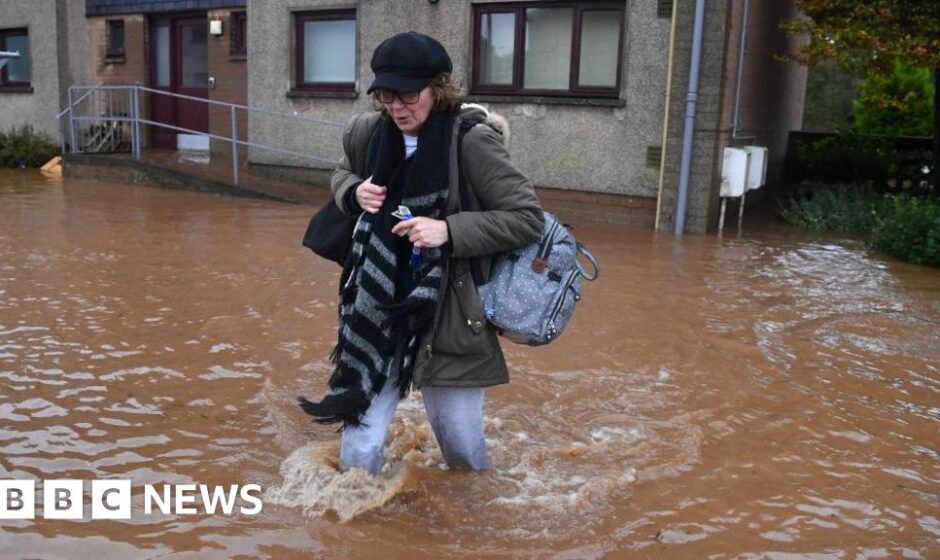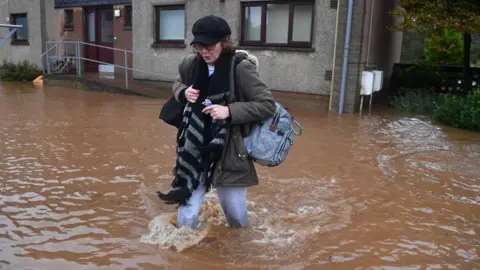 Getty Images
Getty ImagesScotland’s transport networks are set to be tested in the coming weeks as winter brings an increased likelihood of extreme weather.
Last year the country was battered by the winds of Storm Bert and Storm Darragh.
And in January one driver was killed, buildings were damaged and thousands of homes were left without power as Storm Éowyn swept in.
As operators outlined resilience plans for the season, the Met Office’s John Harrison said: “Being prepared for severe weather is the best way of minimising impacts.”
BBC Scotland News takes a look at the measures in place to keep people safe.
What is being done to prepare the roads network?
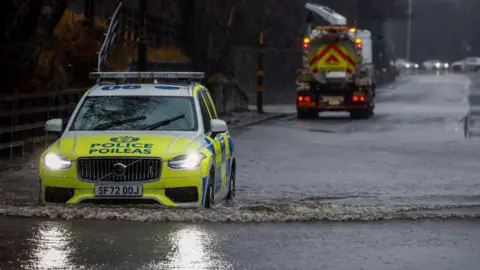 Getty Images
Getty ImagesThe roads network is often the focal point of weather-related disruption and, in recent times, people have become used to the Met Office’s colour-coded travel warnings.
But the threat is not restricted to the winter, as illustrated by Storm Floris in August and, more recently, Storm Amy.
Statistics also back up the reality that severe weather is now an all-year-round problem.
For example, over the last three years flooding has restricted the trunk network for an average of 62 days each year.
This compares with an average of 20 days from 2015 to 2017.
Scotland’s annual winter service will see around 240 gritters undertake salt spreading and snow ploughing patrols of the trunk road network.
The winter preparations include dedicated snow plans for key routes like the M8, M74, M77, M80 and the Aberdeen Western Peripheral Route.
And around 497,000 tonnes of salt is already in stock – more than was used for the entirety of last winter.
Martin Thomson, Transport Scotland’s national operations manager for resilience, said modern technology was at the forefront of plans to manage severe weather.
“In addition to work on the Queensferry Crossing to mitigate ice, a new advanced weather forecasting system, new sensors to provide early warning of risk levels, and automatic barriers are now in play, if required.
“Effective communications with the public and stakeholders is also critical.”
 Getty Images
Getty ImagesChief Supt Scott McCarren, Police Scotland’s head of road policing, said a multi-agency approach was necessary to “prepare, respond and recover” from severe weather.
Officers are embedded with Transport Scotland and work alongside trunk road operating companies to gain an overview of traffic management.
But Chief Supt McCarren also urged the public to play their part.
He said: “Everyone can help emergency services by planning ahead, check for road closures in advance, pay attention to weather warnings and listen to travel advice.”
How ready is the rail network?
 Supplied
SuppliedThe challenges facing the rail network during extreme weather came into sharp focus last week when a train travelling from Glasgow to London derailed near Shap in Cumbria.
The Avanti West Coast service came off the tracks on the West Coast Main Line at 06:10 on 3 November while travelling at 80mph.
Of the 87 people on board, including staff, four were left with minor injuries but no-one required hospital treatment.
Network Rail has invested heavily in safety measures since a Glasgow-bound train came off the rails at Carmont, Aberdeenshire, after it hit a landslide following heavy rain.
Driver Brett McCullough, 45, conductor Donald Dinnie, 58, and passenger Christopher Stuchbury, 62, died in the crash on 12 August 2020.
From 2024 to 2029, Network Rail plans to spend £1.9bn in infrastructure renewal, including £400m on weather resilience.
These measures include wireless tilt meters – deployed at over 130 sites across Scotland – which detect slope movement and alert control teams.

Network Rail has increased its use of helicopters for lineside inspections and aerial surveys in a bid to identify risks.
Its specialist equipment includes snowploughs and a £1m Winter Train for defrosting infrastructure.
The company has also allocated more than £100m – double its previous spend – to targeting issues such as hazardous trees and overhead line risks.
Ross Moran, route director at Network Rail Scotland, said teams were ready to respond throughout the year to conditions including strong winds, flooding and ice.
He said: “Storms Amy and Floris showed how quickly conditions can change and how important it is to have boots on the ground and the right technology in place.”
What’s happening with ferries?
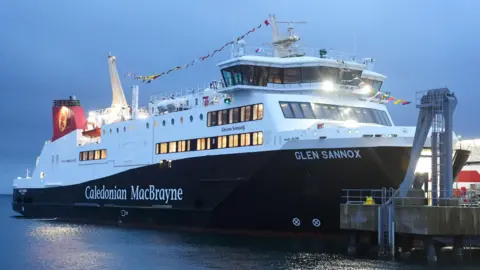 PA Media
PA MediaRecent storms have been responsible for widespread delays and cancellations across Calmac’s ferry network.
Finlay MacRae, head of operations, said: “CalMac operates lifeline services within a complex marine landscape, which means that challenging weather conditions can affect our ability to operate effectively.
“Planning is key when it comes to severe weather, so we actively take part in resilience partnerships and planning events across our network with emergency services, local authorities, and other transport providers.”
Mr MacRae said the company aimed to “deliver clear messages as early as possible” online or through frontline staff when significant weather events are forecast.
What is the Scottish government saying?
 Scottish Goverment
Scottish GovermentTransport Secretary Fiona Hyslop warned the impact of climate change had been dramatic in recent years.
And she said it was vital for people to work together to keep the country moving.
She added: “Severe weather has traditionally been associated with winter, snow, ice and gritters.
“However, we just have to look back at the impact of Storm Amy and Storm Floris to realise that we can face challenging conditions at any time of year.”
The minister said hard work was being done behind the scenes to mitigate problems before they arise, but she encouraged travellers to plan ahead when conditions take a turn.
Hyslop said: “The Met Office’s named storm process and Traffic Scotland’s gritter tracker have all helped raise awareness of the issue.
“But the public also have a role to play – from drivers making sure their vehicles are winter ready to commuters on the rail and ferry networks checking with operators ahead of time to see how services are affected.
“Because of climate change, we are seeing more frequent heavy rain and more weather extremes throughout the year.”
Health Secretary Neil Gray will make a statement on Thursday to MSPs on winter preparedness and national planning priorities.
What other winter preparations are under way?
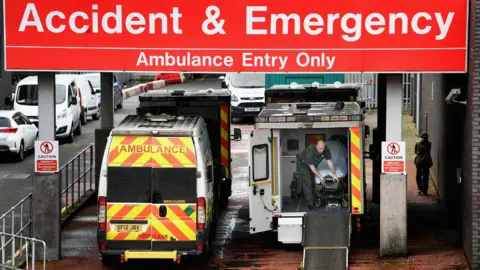 Getty Images
Getty ImagesEarlier this week, the health secretary announced almost 100 new ambulance staff had been recruited to help the NHS cope with the traditional surge in patients at this time of year.
Last winter, the Scottish Ambulance Service (SAS) was placed on the highest level of emergency due to the “significant pressure” placed on services.
Neil Gray also confirmed that more than 250 newly-qualified paramedics were also expected to be recruited this year.
But Scottish Conservatives health spokesman Sandesh Gulhane said the numbers were a “drop in the ocean”.
Waiting times came under the spotlight last week after it emerged a Queen’s Park footballer with a dislocated knee waited nearly 10 hours for an ambulance.
Charlie Fox was hurt during the Glasgow club’s 5-0 defeat to Partick Thistle on Saturday.
But he was left waiting until about 01:00 on Sunday before an ambulance arrived at Firhill stadium.
The health secretary later apologised to the player.
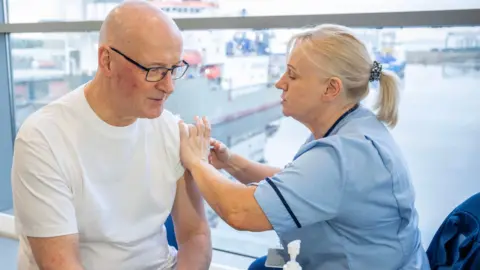 PA Media
PA MediaMeanwhile, SAS chief executive Michael Dickson warned that there was already an increase in demands on the service compared to last year.
He said: “To help our staff over winter, we’d like to remind the public that if you need urgent care, but it’s not life-threatening, you can call NHS 24 on 111, day or night, or visit your GP during opening hours.”
First Minister John Swinney has already urged all those eligible for a flu vaccination this year to take up the offer.
Last year, more than 6,500 adults were hospitalised with the virus, which increased strain on the NHS.
Eligible groups include people 65 years and older, pregnant women and those with certain health conditions.
Unpaid carers and health and social care staff are also eligible as the vaccine helps prevent transmission of the virus to those they are caring for.
What impact did the weather have last winter?
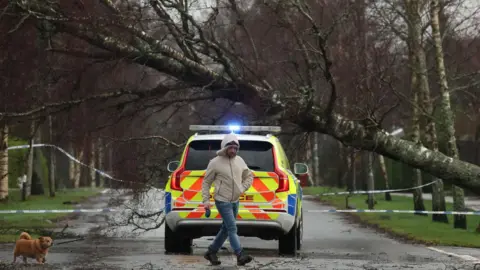 Getty Images
Getty ImagesLast November, Storm Bert brought snow to Scotland’s central belt leading to disruption to public transport and the cancellation of sporting fixtures.
The Queensferry Crossing across the Firth of Forth was closed for the first time since 2021 due to the threat of falling ice.
The following month, Storm Darragh caused damage and disruption to some parts of the country, with an amber warning for high winds and yellow warnings for wind and rain.
Strong winds tore a large section of the roof off Castle Douglas High School and part of it it landed on another part of the school.
In January, forecasters issued a rare red warning ahead of the arrival of Storm Éowyn.
It claimed the life of a teenager in Ayrshire after his car was struck by a falling tree.
The 19-year-old was critically injured on the B743 in Mauchline, but died the following day from his injuries.
Network Rail Scotland said 400 incidents of damage had been recorded on the country’s railways after the storm passed, including more than 120 trees and other debris.
Jim Dale, senior meteorologist at British Weather Services, said it was one of the most significant storms of his 40-year career.
He told the BBC’s Good Morning Scotland programme: “People will recognise this in terms of the damage that has been done.
“But you can imagine if there had been no warnings, if people hadn’t heeded those warnings – red and amber as they were – then the casualty list would have been far, far higher.”
#prepared #Scotland #severe #weather #winter
